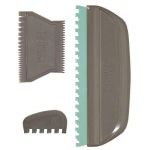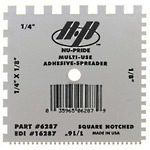There are many tools you can use to create a paint combing effect. There are lots of tools on the market sold just for this very particular faux painting technique.
While a rubber comb is one popular choice, a look around your garage will turn up some great faux combing tools. Nothings better than using something you already have on hand.
Here are a few thoughts from a professional painter.
Use a squeegee.
 Notch out the rubber end of the squeegee with a sharp razor knife or scissors. To make thin lines, cut out several notches close together. For wider lines, cut fewer notches and space them farther apart. This is a great opportunity to create a patterned combing effect by varying the width of the notches.
Notch out the rubber end of the squeegee with a sharp razor knife or scissors. To make thin lines, cut out several notches close together. For wider lines, cut fewer notches and space them farther apart. This is a great opportunity to create a patterned combing effect by varying the width of the notches.
For instance, you could cut out five thin notches, then two wider ones. Essentially, you’ve created “teeth” on the squeegee that will pull off the glaze.
Use a plastic notched trowel or adhesive spreader.
 These are available at any hardware store and they work well, although not as well as a modified squeegee. These are available with different notch sizes, sometimes on the same tool. Use only the plastic “V” or square notch trowels, sharp steel edges will scratch the wall surface, causing damage.
These are available at any hardware store and they work well, although not as well as a modified squeegee. These are available with different notch sizes, sometimes on the same tool. Use only the plastic “V” or square notch trowels, sharp steel edges will scratch the wall surface, causing damage.
Use a grooming comb.
That’s right, you’ve found a new use for that unwanted comb! Be sure that the teeth of the comb are in good condition. A brittle comb with broken teeth could surprise you as you are working by losing more teeth. You also don’t want a comb with bent teeth in most cases.
Using a grooming comb makes for a lovely comb paint effect, but realize that it is a bit difficult to keep the dragging straight, and errors will be more noticeable.
Use a stiff brush.
Do you have an old paint-brush that become stiff and useless for normal painting jobs? It just might be the tool you need for your combed painting project. That stiff paintbrush (choose one 3″ or wider) could create an interesting pattern.
Use a whisk broom.
A small hand broom works wonders to create a lovely combing effect. The uneven spacing of the old traditional corn broom is a natural for this technique. If you use a synthetic broom, look for one that has coarser ends, rather than a broom that has fuzzy ends. The fuzzy ends will work more like a paint brush and will make it more difficult to use the combing technique which is a take-away technique rather than an add-on technique like strie painting.
Generally, squeegees, brushes and brooms are easier to keep moving in a straight line and blend easier than combs. Errors are less noticeable.
As you can see, faux combing offers so many ways to mix up the look. Once you’ve practiced the basic combing technique, I encourage you to play with color combinations, combing tools, and line variations. Changing any one of these variables will create an entirely new look! The possibilities are nearly endless.
Related Articles
Strie Faux Painting, Creating the look of fabric using paint.
How to use a guide to make even paint combing lines.
About the Author:
Crowder Painting in Colorado Springs delivers top-notch interior and exterior painting services with a focus on precision and quality. Contact us today!

